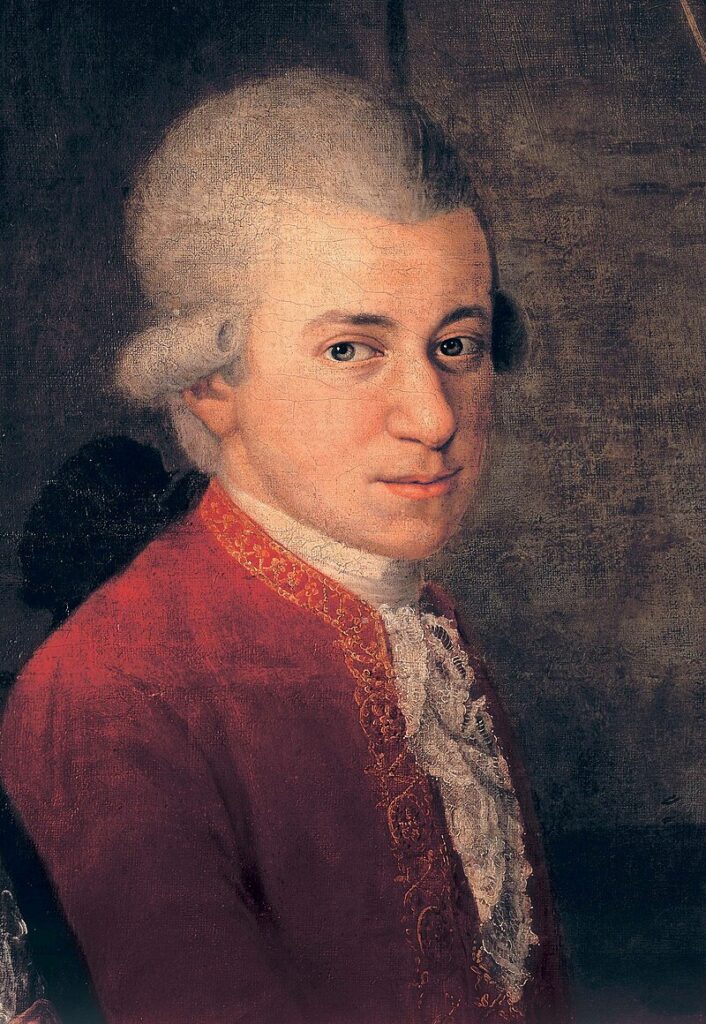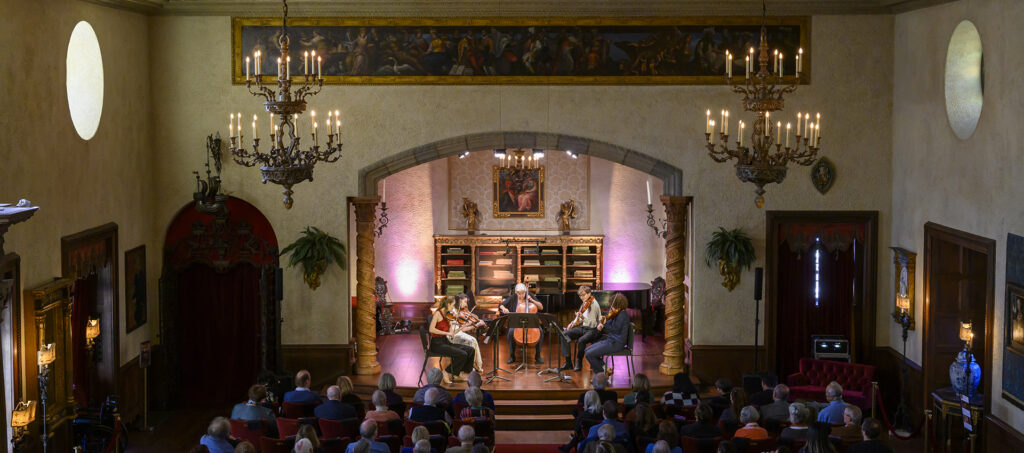For event info and tickets to the Evnin Rising Stars performances on October 28 & 29, please visit Caramoor.org/Events.
“People have heard of Boccherini, but they don’t hear his music enough,” explained cellist Marcy Rosen in our conversation about this weekend’s pair of Evnin Rising Stars programs. Luigi Boccherini (1743-1805)was an Italian composer and cellist who was a contemporary of Franz Joseph Haydn (1732-1809) and in many ways their careers paralleled each other. Haydn is often called the father of the string quartet because his 68 compositions for two violins, viola, and cello set the standard for the genre. What many do not know is that Boccherini wrote nearly 100 string quartets that were nearly as popular as Haydn’s to musical consumers of the late 18th century. Haydn wrote his first set of quartets between 1755-1760. As Haydn was not allowed to publish them due to the terms of his initial contract with the Esterhazy court, leaked copies made their way to Vienna and other musical capitals where publishers made pirated editions of the quartets that became all the rage.

Haydn did not compose string quartets again for eight years due to his overwhelming obligations to compose the operas and baryton trios for the Esterhazy court. Some credit the initial publication of Boccherini’s first set of string quartets in 1767 (and their very popular reception) as rekindling Haydn’s interest in composing works for the genre, due in no small part to his competitive spirit. Much is made of how Wolfgang Amadeus Mozart (1756-1791), via his set of string quartets dedicated to Haydn, provided inspiration to the composer to further innovate the genre. With the sheer volume of Boccherini’s works one cannot discount that he also played a part in inspiring Haydn to tinker with the string quartet as well.
In 1770 Boccherini was appointed compositore e virtuoso di camera in the court of the Infante Don Luis in Aranjuez (near Madrid), a position he would hold until the Infante’s death in 1785. Boccherini composed pieces in many instrumental combinations, but as the Infante already had a resident string quartet in his court Boccherini composed quintets that he could play with the quartet, often writing cello parts that would serve as a vehicle to exhibit his virtuosity. He went on to write over 100 string quintets, and it is these works that mark Boccherini’s unique contribution to the chamber music repertoire. Both of the quintets on this weekend’s programs date from Boccherini’s time in the Infante’s court.

“I have a nice long history with Boccherini,” remarked Rosen after she showed me the postcard-sized portrait of the composer that hangs over her desk. “I started exploring his music at Marlboro with the Italian violinist, Pina Carmirelli. I was 18 when I first went to Marlboro and had the privilege of working with her. She was a huge influence on me as a musician, and I got to play a bunch of Boccherini quintets with her.”
Carmirelli, who died in 1993, was known not only as one of the foremost violinisits of her time but also as an editor of works by Vivaldi and Boccherini; she spearheaded the creation of a revised edition of Boccherini’s instrumental works and is largely responsible for bringing his works back into the repertoire. She was a founding member of the Boccherini Quintet in 1949 and the Carmirelli Quartet in 1954; both groups focused on exposing Boccherini’s quartets and quintets to listeners via touring and recording.
Since many of Boccherini’s works did not exist in modern performance editions, Carmirelli often manually extracted them from scores. Rosen possesses physical proof of this labor of love. “I went into my own library, where I had parts that I stole years ago, parts of Boccherini’s quintets in Pina’s handwriting, because they had not been published. She had handwritten from the scores all the parts out. So this past summer I thought maybe it was time for me to return those [to the Marlboro library] if they wanted them back. It turns out they didn’t really need any of my stolen parts back, which was a relief. But nobody had really been playing Boccherinii quintets up there for a long time.”
Rosen shared that after that initial summer at Marlboro “we had a group on the outside called the Boccherini Ensemble which was made up of Pina Carmirelli, [violinist] Naoko Tanaka, [violist] Philip Naegele; I was the first cellist; and Robie Brown Dan was the second cellist. We made two recordings, two LPs of Boccherinii quintets. So I was thrilled to actually circle back to play some of these pieces again. I went through a lot of music and picked two of the quintets that I’d worked on with Pina years ago, and I’m very excited about working on those pieces with the incredible young performers at Caramoor. These pieces are very challenging. So I’m grateful I get to play second cello now, and I can let Gabriel and Chase play the difficult part. But hopefully we’ll have fun with this music, as I always found it utterly inspiring … I hope the music will will stand out as refreshing and will make people just thrilled to have heard it.”
String quintets featuring an extra viola were the hot genre of the late 1780s in Vienna. Many consider Mozart’s four viola quintets written between 1787-1791 as the pinnacle of his chamber music output. (It should be noted here that the viola was Mozart’s instrument of choice!) He had explored the combination earlier in 1773 during his time in Salzburg but did not pick it up again until 1787. These quintets exhibit the innovative use of counterpoint that Mozart explored in his set of string quartets dedicated to Haydn while also channeling the operatic drama of Le nozze de Figaro (1786), Don Giovanni (1787), Cosi fan Tutte(1790), and Die Zauberflöte (1791). Mozart’s K. 516 Quintet featured this weekend is particularly brooding, possibly due to the fact that it was composed in May 1787, the same month that his father Leopold died. Mozart’s choice to feature a slow introduction to the fourth movement rondo after the third movement (a lament tinged with hope) adds a sense of emotional weightiness balanced with fragile happiness. “It’s a really enormous range of emotions in the Mozart. It has a sort of more brooding quality and pulling inwardly at the heart. There’s also a certain edginess to it, a little bit of agitation in there,” remarked Rosen.
The combination of string quartet and double bass was also something that Boccherini explored; the texture in some ways is similar to having two cellos play but there is definitely added resonance provided when accessing the lower registers of the double bass. Antonín Dvořák (1841-1904) wrote a String Quintet in G major in 1875 which is one of the more popular pieces written for this combination. Edgar Meyer ( b. 1960) takes on Boccherini’s spirit of writing a quintet that explores the virtuosity of his own instrument. The composer provided this program note in the liner notes to the recording of the Quintet he made with the Emerson String Quartet:
The Quintet was written in 1995 to be performed by the Emerson String Quartet and myself. It was commissioned by a consortium consisting of Performing Arts Chicago, UCLA , the Lied Center at the University of Kansas in Lawrence, the Minnesota Public Radio series Saint Paul Sunday Morning, The Lively Arts at Stanford, and Harold and William Slapin. One of my primary goals in writing the quintet was that it be clearand self-explanatory. Given this goal, detailed notes could be considered a distraction or even a failing, so please forgive the brevity of these. The piece is in four movements. The first is a cross between theme and variations and variations on a ground bass. The second movement is moderate with some sense of humor. The third is slow and devoid of humor. The fourth is fast (and difficult). If this leaves you wondering what to expect, all the better.
Rosen shared a few anecdotes about her friendship with Meyer over the years, “starting back when he was just beginning, when he wrote his first string trio, which was the first real thing that got him into composing. He wrote that in Santa Fe at my house drinking beer many, many years ago. It’s a very cool piece. Everybody was really blown away by it back then. The kind of playing he asks from people is not just what he does himself. He asks for people to do amazing stuff that most classically trained musicians are not quite at ease with. You have to learn his language just like you do with any composer, but you have to get into his groove. I think the audience is going to love his Quintet because it’s so super unusual. It’s very personable and very reflective of Edgar.”
Concertgoers tend to associate the piano quintet genre with the combination of a piano with two violins, viola, and cello. Boccherini actually experimented with this combination in 1797-1799 but not until Robert Schumann (1810-1856) wrote his Piano Quintet in Eb major in 1842 did the genre take root. In between 1799-1842 the double bass tried to get into the mix in works written for piano with violin, viola, cello and double bass.

Franz Schubert (1797-1828) wrote his Piano Quintet in A major, “Trout”, D 667 in 1819. Schubert was invited to go on holiday with a friend to Steyr in Upper Austria. Sylvester Paumgartner, an assistant manager of iron mines in the region, liked to host musical soirées at his house and was particularly enamored with a quintet by Johann Nepomuk Hummel (1778-1837) which featured the double bass combination. Paumgartner asked Schubert to write a companion piece to the Hummel and he agreed. The piece is nicknamed “The Trout” because Schubert quotes his song bearing the same name in the fourth movement of the quintet, using it as a theme which serves as the basis for the variations that follow.

Hungarian composer Ernö Von Dohnányi (1877-1960) kept the music he wrote firmly in the world of Brahms. (As a performer and conductor, he toured Europe and the U.S. championing neglected works of Mozart, Beethoven, and Schubert, and he was one of the first concert pianists this century to perform chamber music regularly.) Dohnányi attended the Budapest academy from 1894-1897 studying piano and composition. In 1895 he wrote his Piano Quintet No. 1 in C minor, Op. 1. (This one uses the combination of two violins, viola, cello, and piano). His composition teacher, Koessler, was a close friend of Brahms, who when presented with the quintet liked it so much he arranged for a performance of it in Vienna.
“This quintet is incredibly romantic,” shared Rosen. “He wrote this when he was 17… so as a teenage piece, it’s romantic. And it’s charming, and you could call it elegant also. It’s got a lot of great tunes and passionate melodies. It’s a lot of fun to play. It could be considered a little bit Hollywood in terms of going over the top emotionally, or a little bit heart-on-the-sleeve.”
— Daniel Doña
Daniel Doña is a violist and Senior Lecturer in Music at the Boston University School of Music, where he serves as Chair of the Committee for Antiracism & Diversity, Equity, Inclusion, and Access. He is an avid chamber musician and a member of the Arneis Quartet.

Leave a Reply